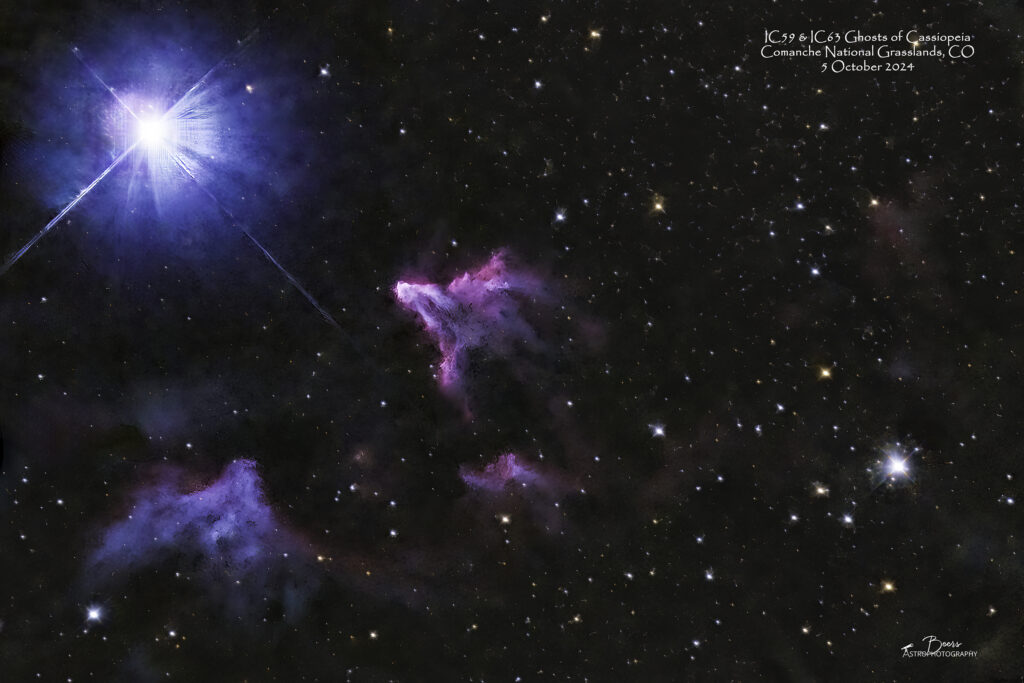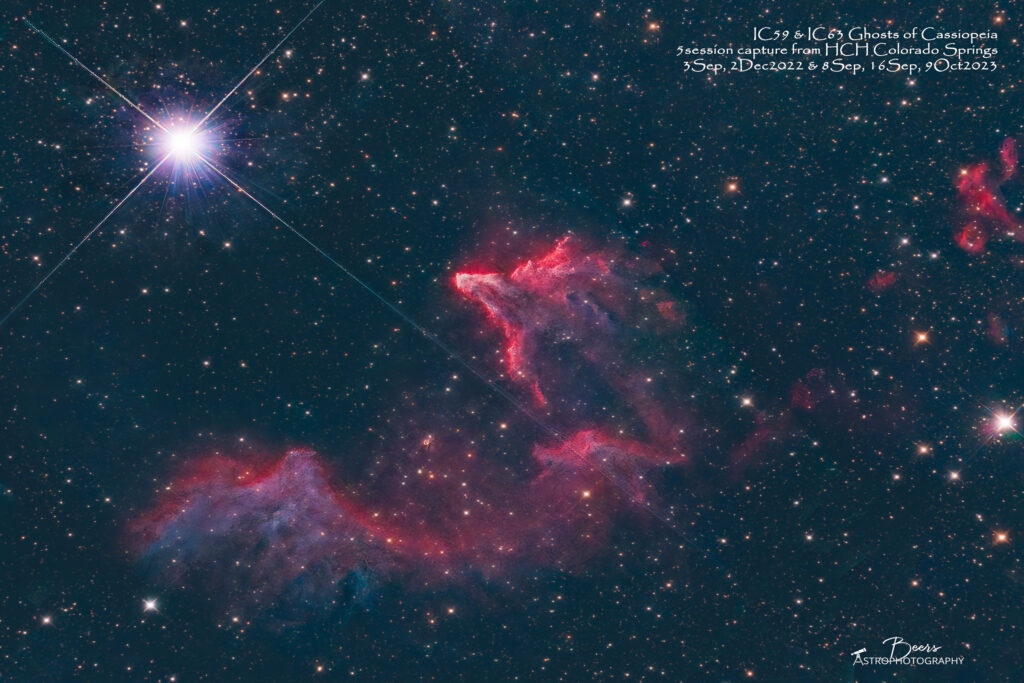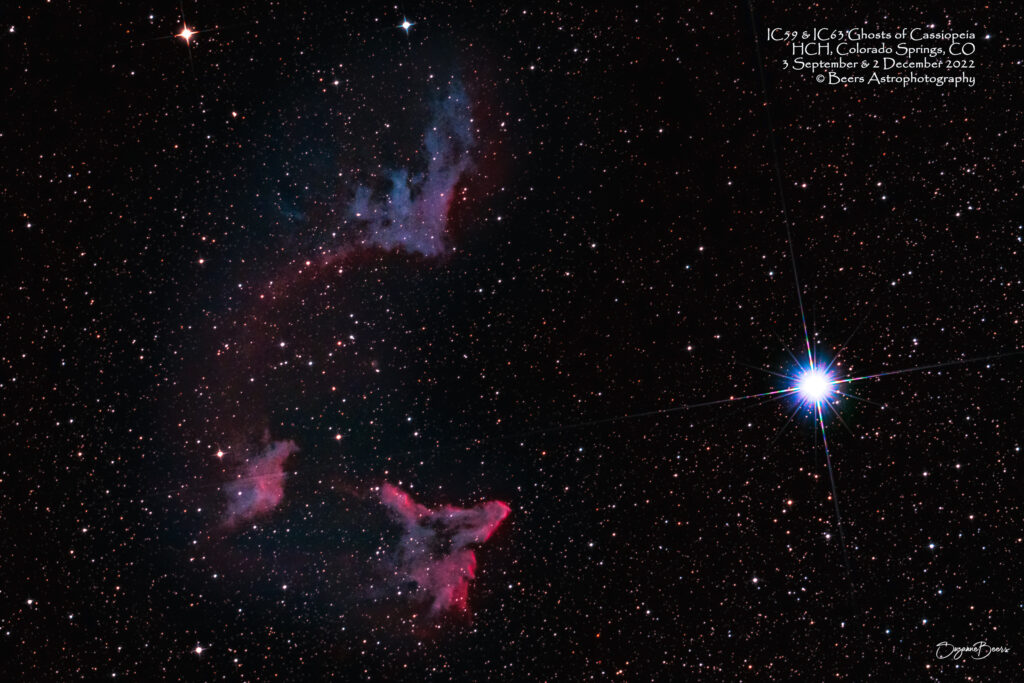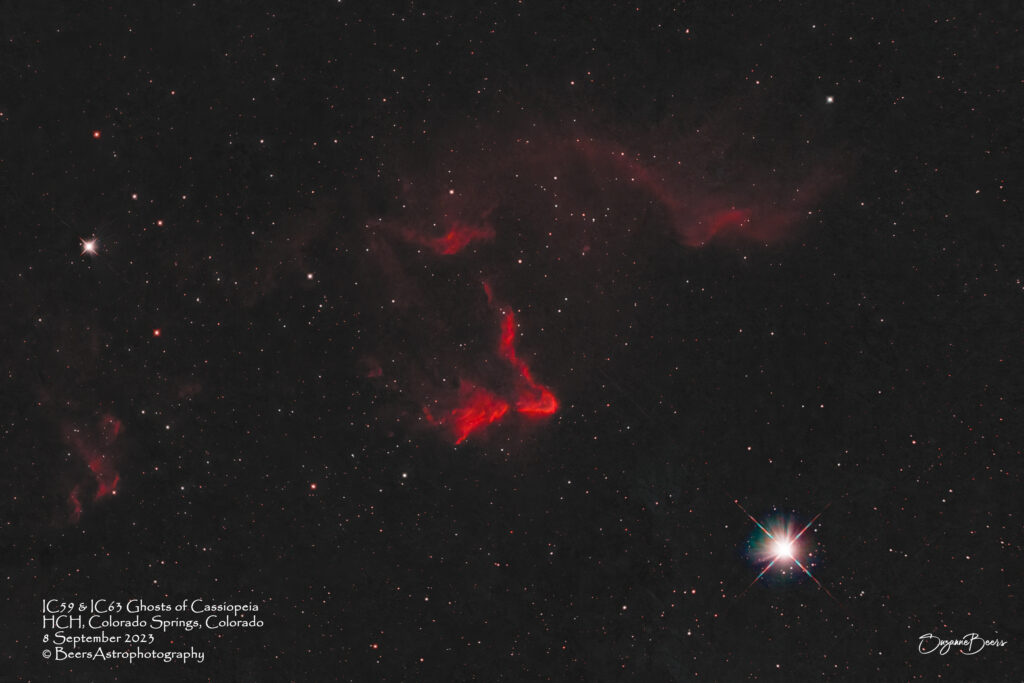
Fun facts
IC 59 and IC 63, known together as the Ghosts of Cassiopeia are faint reflection and emission nebula located in the northern constellation of Cassiopeia. Both nebulae are faint at apparent mag. +10, they have extremely low surface brightness and surround bright variable star gamma Cas (γ Cas). This remarkable star is partly unstable and is known as a “shell star”. It currently shines at mag. +2.15, making it the brightest star in Cassiopeia.
IC 59 and IC 63 are 610 light-years distant. From our perspective, IC 59 is located on the northern side of gamma Cas and IC 63 to the northeast. Spatially the nebulae are roughly 3 light-years from gamma Cas, although IC 63 is slightly closer to the star. As a result, it’s appears mostly red due to a dominance of H-alpha emission, whereas IC 59 exhibits much less H-alpha emission and appears mostly blue due to dust reflected starlight.
Other Catalog Designations: IC59, VdB 5, LDN 620, Ced A; IC63, VdB 5, LDN 624, Ced 4b
Subtype: Reflection and Emission Nebula
Distance from Earth: 610 light years
Visual Magnitude: 13.3
Constellation: Cassiopeia
{ Target information from: Stellarium and https://freestarcharts.com/ic-59 }
Capture Notes
IC59/IC63 Ghosts of Cassiopeia was the first target for Big Bertha on our first night at the Comanche National Grasslands Camel Rock camping site during our October dark skies trip.
We set up the camp (first clearing the cactus and large rocks). I didn’t start setting up the AP equipment until about 1800 – so ended up finishing the set-up of Big Bertha in the dark, thus decided I was going to forego attaching the autofocuser for the first night. I attached the TS Optics field flattener – which turned out to be a bad idea – creating more coma throughout the entire field than it cured in the corners. I got the Southern Cross going on its target first and then turned my attention to Big Bertha.
I had some (what I thought was strange at the time) power/connection issues with the RST-300 (BB’s mount) which was connected to the dedicated “power panel” that Paul had installed on the passenger side of the Beast, that draws from the house batteries. The power booster that Paul designed constructed was connected to the end of DC cable coming from that power panel – which works like a charm to give greater than 12V power for the RST-300 throughout the night. But the issue was the laptop’s comm port wasn’t being recognized (even though it was showing on Equipment Manager) by the RST-300’s ASCOM driver. Many laptop and mount reboots didn’t solve the problem – only turning the power off, disconnecting the power cable from the Beast’s power panel and the power booster and starting from a cold start solved the issue (and then it worked fine throughout the night).
I had the sequence set up for 10 second, 180 second, and 300 second subframes. I sequenced through the 10 second and 180 second subframes and began collecting on the 300 second subframes before it was time to switch to the second target of the night. When it came time to process, I used only the 180 second subframes because the 10 seconds were too dim and the 300 second subframes were blown out.
Equipment
Equipment: All equipment controlled by HP Probook running Sequence Generator Pro v4.4.1.1441.
Autoguiding: Orion 60mm Multi-Use Guide Scope with Orion StarShoot AutoGuider Pro Mono Astrophotography Camera (controlled by PHD2)
Imaging (ASI2400-BB-FF): ZWO ASI2400MC imaging camera on (Big Bertha) Orion 8″ f/8 Ritchey-Chretien Astrograph Telescope, Teleskop Service Flattener 1.0x for RC Telescopes (TS-RCFLAT2)
Autofocuser: ZWO EAF Electronic Automatic Focuser (EAF-5V-STD) Did not assemble the autofocuser on the first night of the trip.
Mount: Rainbow Astro RST-300 (controlled by iHubo ASCOM driver)
Polar alignment: QHYCCD camera (controlled by Polemaster for polar alignment)
Sequence Data Capture & Processing
Sequence Plan (5Oct2024): Gain: 158, Temp: -0°C, offset=30. 20x10sec, 35x180sec, 4x300sec. Captured 5Oct2024, 22:34MDT – 6Oct2024, 00:53MDT. Total collected data: 2:08hrs. (Only used the 180 second data in the processed image, 35x180sec = 1:45hrs)
Processing: Captured in SGP, stacked in APP (Adaptive Airy Disc), star removal with Starnet++, processing with LR/PS
Other Images of the Ghosts of Cassiopeia
Multi-session (5-sessions) image with data captured from HCH front patio: 2022-2023

Capture Notes
Overall Sessions’ Capture Notes Summary: I have been collecting data on IC59&IC63 Ghosts of Cassiopeia for over a year – all from the front patio, with mixed results (mostly bad!). This image is comprised of data collected over two sessions in 2022 (2Sep2022, 2Dec2022) with Big Zeus – which seemed to exacerbate the halos from Navi with its open – and three (of four) sessions in 2023 (8Sep23, 16Sep23, 9Oct23). I also collected data on 15Sep2023, but excluded it from the stack because it was terribly out of focus around the edges as I struggled with getting the correct backfocus with the TSFF.
2Sep2022 Capture Notes: Clear night, decided to give this target a try. The collection went well, but when the sub-frames were stacked, there was a horrible halo around Navi (27 Cas, Gamma Cas). Tried to process it repeatedly, all to more horrible results. See the “final” result of these data combined with data collected on 2 December, in the December chapter of this journal
2Dec2022 Capture Notes: Had this target on the target list for the November dark skies trip, that we cancelled due to my PRP treatment on the Thursday prior to our Saturday departure. The pain in my glut combined with the cold weather predicted during the trip (and the procedure’s precluding icing the areas), begrudgingly had me cancel the trip. So, although I know that this target needs/deserves, dark skies – decided to supplement the data I collected in September with another data set. In September, the collection went well, but when the sub-frames were stacked, there was a horrible halo around Navi (27 Cas, Gamma Cas). Tried to process it repeatedly, all to more horrible results. The “final” result of processing the 3Sep and 2 Dec data using the multi-channel process demonstrated on Astro Ed’s YouTube video, is still not great, but at least taken to fruition… Still carrying this target into December (didn’t happen) and January 2023 (hoping) dark skies trips.
8Sep2023 Capture Notes: This is certainly an “add it to the list of targets to reshoot in dark skies.” The LeX filter is obviously too extreme for this Mag=13.33 target to have any of the “mostly blue” coming through. I’ll post it on the website as a placeholder for better images to come. After a week of clear nights and a waning moon (72% on Monday when I captured the Cave Nebula, 61.9% Tuesday, 51.6% Wednesday, 41.6% Thursday, to a late rising (0012MDT) 32.1% on Friday night) where I had promised Paul I would get some sleep to be rested for an important work meeting (interview for A&SFC Distinguished Chief Engineer) on Friday midday; I was chomping at the bit to take advantage of Friday’s clear night. Especially since the forecast for the next week, when we were planning our dark skies trip had turned south – rain storms and clouds everywhere. I began the night imaging NGC6992 Eastern Veil Nebula, initially planning to image that all night. When I looked at the time it set – 0330MDT – and knowing it was a Saturday morning when I could image until the end of nautical twilight, I opted for IC59/IC63 as the second target for the night. I imaged Veil until approximately 0230MDT, when the Ghosts were past their meridian flip, and switched to them for the rest of the night. Again, the autoguider is much more reliable on the west side of the meridian – starting about 15 minutes after the flip for the rest of the night. It was while I was laying away thinking about the interview and the imaging that it came to me that I had switched the SGP sequences from auto-meridian flip about the time I started having problems. So, on Saturday, I went back to the auto-flip at 20 minutes (~5 degrees) past the meridian.
16Sep2023 Capture Notes: This was captured on Saturday night, the clear night after a long wet, rainy, cloudy, stormy spell (see the entries from 9 September – the weekend before the rains started). I got a second Optilong LeXtreme filter this week, I got the ASI2400MC DC power cable from Tolga, and Paul finished up the “Chile” battery, so with that I now have two of everything and can run two rigs simultaneously. That is exactly what I did. I started the night getting Big Bertha going first on her target(s) as she was planned to image two targets. This was the first of the two targets captured from dark until about 0230MDT when it was getting close to setting and IC59IC63 Ghosts of Cassiopeia was past its meridian flip.
9Oct2023 Capture Notes: This was captured on Monday night, 9 October 2023. The moon was at 18% and didn’t rise until 0300 (10Oct), so decided to give a try to imaging from the front patio with Big Bertha and the LPro filter. I captured most of the night with 5 minute exposures, with a few 3 minute subframes near the end of the night (that ended prematurely for some reason) to get a better version of Navi to blend into the image. The LPro definitely lets through more blue signal.
Equipment
All equipment controlled by HP Probook Windows 11 laptop running Sequence Generator Pro
Polar alignment: QHYCCD camera (controlled by Polemaster)
Imaging: (Big Bertha) Orion 8″ f/8 Ritchey-Chretien Astrograph Telescope, ZWO ASI2400MC#2 imaging camera, Optolong LeXtreme light pollution filter
(Big Zeus) Orion 10″ f/8 Ritchey-Chretien Astrograph Telescope, Canon EOS Ra with with Teleskop Service Flattener 1.0x for RC Telescopes (TS-RCFLAT2) and Optilong L-Pro LP filter and Optolong LeXtreme LP filter.
Mount: SkyWatcher EQ6‑R PRO Synscan mount (controlled by ASCOM driver)Autoguiding: Orion 60mm Multi-Use Guide Scope with Orion StarShoot AutoGuider Pro Mono Astrophotography Camera (controlled by PHD2)
Sequence Data Capture & Processing
Session #1 (3Sep2022): ISO1600; 152x180sec; captured 3Sep2022, 2110MDT – 4Sep2022, 0526MDT. Total exposure time: 7:36 hrs.
Session #2 (2Dec2022): ISO3200; 97x300sec; captured 2Dec2022, 1823MST – 3Dec2022, 0301MST. Total exposure time: 8:05hrs.
Session #3: (8Sep2023): Gain: 158, Temp: -0°C, offset=30; 50x3min; captured 8 September 2023 (9Sep2023, 0259 –0538MDT). Total exposure time: 2:30hrs.
Session #4: (16Sep2023): Gain: 300, Temp: -0°C, offset=30; 36x5min; captured 16 September 2023 (17Sep2023, 0240 –0556MDT). Total exposure time: 3:00hrs.
Session #5: (9Oct2023): Gain: 300, Temp: -0°C, offset=30; 60x5min; captured 9 October 2023 (9Oct23, 2312 – 10Oct23, 0433MDT); (Captured but not included in the stack: 10x3min; captured 10Oct23, 0433 – 0505MDT.) Total exposure time: 5:30hrs.
Total exposure time: 202x3min + 193x5min = 26:40hrs
Processing: Captured in SGP, stacked in APP (5session, HaOIII Color, RGGB Debayer, Camera White Balance); Star removal with Starnet++, processing with LR/PS
HCH Front Patio two-session image: 2Sep2022 & 2Dec2022

Capture Notes
Time off work for MLK Jr. holiday and due to MITRE’s PTOB balance change, Mother Nature vetoed the upcoming dark skies trip, and new computer ordered motivated me to get through the “C:/Current Project” directory and catch up on processing. So, first image to attack was the multi-session IC59&IC63 Ghosts of Cassiopeia – that had been languishing unprocessed (rather, processed multiple times and made a mess of it trying to clean up the halos around Navi). Decided to give Matt Russell and StarXterminator a try…worked out very well! Still not as good as data that could have been captured in dark skies – but, must make the most of any clear skies available. These data were captured on 3 September 2022 with RaBZ and the LPro filter and on 2 December 2022 with RaBZ and the LExtreme filter.
2Sep2022 Capture Notes: Clear night, decided to give this target a try. The collection went well, but when the sub-frames were stacked, there was a horrible halo around Navi (27 Cas, Gamma Cas). Tried to process it repeatedly, all to more horrible results.
2Dec2022 Capture Notes: Had this target on the target list for the November dark skies trip, that we cancelled due to my PRP treatment on the Thursday prior to our Saturday departure. The pain in my glut combined with the cold weather predicted during the trip (and the procedure’s precluding icing the areas), begrudgingly had me cancel the trip. So, although I know that this target needs/deserves, dark skies – decided to supplement the data I collected in September with another data set. The “final” result of processing the 3Sep and 2 Dec data using the multi-channel process demonstrated on Astro Ed’s YouTube video, is still not great, but at least taken to fruition… Still carrying this target into December (didn’t happen) and January 2023 (hoping) dark skies trips.
Equipment
Polar alignment: QHYCCD camera (controlled by Polemaster)
Imaging stream: Orion 10″ f/8 Ritchey-Chretien Astrograph Telescope, Canon EOS Ra with with Teleskop Service Flattener 1.0x for RC Telescopes (TS-RCFLAT2) and Optilong L-Pro LP filter
Mount: Sky-Watcher EQ6-R Pro Equatorial Mount (controlled by EQMOD)
Autoguider: Orion 60mm Multi-Use Guide Scope, Orion StarShoot AutoGuider Pro Mono Astrophotography Camera (controlled by PHD2)
All equipment controlled by HP Probook running Sequence Generator Pro v3.2.0.660.
Sequence/data & processing notes
Session #1 (3Sep2022): ISO1600; 152x180sec; captured 3Sep2022, 2110MDT – 4Sep2022, 0526MDT. Total exposure time: 7:36 hrs.
Session #2 (2Dec2022): ISO3200; 97x300sec; captured 2Dec2022, 1823MST – 3Dec2022, 0301MST. Total exposure time: 8:05hrs.
Total: Combined session image is: 152x180sec + 97x300sec; Total exposure time: 15:41 hrs.
Capture: 3 September & 2 December 2022
Shooting location: Colorado Springs, Colorado
Processing: Stacked in APP, processed in LR/PS.
HCH Front Patio image: 8 September 2023

This is certainly an “add it to/keep it on the list of targets to reshoot in dark skies.” The LeX filter is obviously too extreme for this Mag=13.33 target to have any of the “mostly blue” coming through. I’ll post it on the website as a placeholder for better images to come.
Capture Notes (8 September 2023): After a week of clear nights and a waning moon (72% on Monday when I captured the Cave Nebula, 61.9% Tuesday, 51.6% Wednesday, 41.6% Thursday, to a late rising (0012MDT) 32.1% on Friday night) where I had promised Paul I would get some sleep to be rested for an important work meeting on Friday midday; I was chomping at the bit to take advantage of Friday’s clear night. Especially since the forecast for the next week, when we were planning our dark skies trip had turned south – rain storms and clouds everywhere. I began the night imaging NGC6992 Eastern Veil Nebula, initially planning to image that all night. When I looked at the time it set – 0330MDT – and knowing it was a Saturday morning when I could image until the end of nautical twilight, I opted for IC59/IC63 as the second target for the night. I imaged Veil until approximately 0230MDT, when the Ghosts were past their meridian flip, and switched to them for the rest of the night.
Capture & Processing
Image train: (Big Bertha) Orion 8″ f/8 Ritchey-Chretien Astrograph Telescope, ZWO ASI2400MC#2 imaging camera, Optolong LeXtreme light pollution filter
Sequence plan: Gain: 158, Temp: -0°C, offset=30; 50x3min. Total exposure time: 2:30hrs.
Capture: Captured 9 September 2023 (9Sep2023, 0300MDT – 00538MDT).
Shooting location: HCH, Colorado Springs, CO
Processing: Captured with SGP, stacked with APP, star removal with Starnet++, processed in LR/PS.
